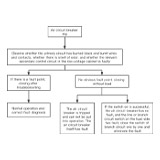
During the use of the relay, due to various reasons, such as poor product quality, improper use, poor maintenance, etc., various failures often occur. Relay troubleshooting is usually analyzed from two aspects: electromagnetic components and contact components. (What are the precautions when using relays?)
Electromagnetic component failure
The faults of electromagnetic components are mainly in the coils and moving and static iron cores.
Coil failure
There are many types of coils used in relays, either outsourced or outsourced. The coils should be separated and placed in special appliances. If they collide and are connected, they will break when they are separated. When the electromagnetic system is riveted, the pressure adjustment of the hand lever press and the press should be moderate, too much pressure will cause the coil to break or the coil frame to crack, deform, and the winding breakdown. If the pressure is too small, the winding will loosen and the magnetic loss will increase. Multi-winding coils are generally made of lead wires with different colors. When welding, pay attention to distinguishing, otherwise it will cause the coil welding error. For coils that have a start and end requirement, the start and end are generally marked with a marking method. Attention should be paid when assembling and welding, otherwise the relay level will be reversed.
Common coil failure:
1. Due to changes in ambient temperature (exceeding the specified value of the technical conditions), the coil temperature rise exceeds the allowable value and causes damage to the coil insulation; the insulation level is severely reduced due to moisture; internal disconnection or short circuit between turns due to corrosion.
2. The coil is damaged due to the coil voltage exceeding 110% of the rated voltage.
3. During maintenance, the coil insulation may be damaged due to the tool's bruising, or the wire may break.
4. Because the coil voltage is connected incorrectly, for example, a coil with a rated voltage of 110v is connected to a 220v power supply voltage, or an AC voltage coil is connected to a DC voltage of the same level and the coil is immediately burned out.
5.When the coil voltage exceeds 110% of the rated voltage, the operating frequency is too high, or when the voltage is lower than 85% of the rated voltage, the AC coil may be burned out because the armature fails to pull in.
6. When the AC coil is connected to voltage, the armature of the AC coil may not be closed due to the failure of the transmission mechanism or jamming, which will cause the coil to burn out.

Iron core failure
If the armature cannot be sucked up after the iron core is energized, it may be caused by the broken wire of the coil, foreign matter between the static iron core, and low power supply voltage.
The armature is noisy after power-on, which may be caused by uneven contact surfaces of the moving and static iron cores, or oil pollution. The coil can be removed and the contact surface can be filed or polished. If there is oil stains, it can be cleaned. The break of the short-circuit ring can also cause loud noise.
After the power is off, the armature cannot be released immediately, which may be caused by the moving iron core being stuck, the iron core air gap is too small, the performance is poor, and the iron core contact surface is oily. During maintenance, the air gap can be adjusted to 0.02-0.05mm, or the spring can be replaced.
Commin iron core failure:
1. The edges and corners and the shaft are worn out, causing the armature to turn ineffectively or stuck.
2. In some DC relays, due to mechanical wear, or damage to the non-magnetic gasket, the minimum air gap after the armature is closed becomes smaller, and the residual magnetism is too large, resulting in a malfunction that the armature cannot be released.
3. When the sub-magnetic ring on the iron core of the AC relay is broken, or the armature and the pole face of the iron core are rusted or invaded, it will cause the armature to vibrate and generate noise.
4. In the e-core of the AC relay, when the air gap of the center column disappears due to the abrasion of the cores on both sides, the armature sticks and cannot be released.
Contact components
Contacts are electrical contact parts used by relays to switch loads. Some products' contacts are press-fitted by riveting. The main drawbacks are loose contacts, cracks in the contacts, or excessive size and position deviation. This will affect the contact reliability of the relay.
The faults of contact components generally include contact overheating, wear, and welding. The causes of contact overheating include insufficient capacity, insufficient contact pressure, surface oxidation or dirty, etc.; causes of wear include too small contact capacity, too high arc temperature to oxidize the contact metal, etc.; the causes of contact fusion welding are too high arc temperature, or serious jumping of contact.
Common contact failures:
1. Due to the mechanical engagement of the contacts (the needle-shaped protrusions and pits formed on the contacts bite each other), welding or cold welding, the phenomenon that they cannot be disconnected occurs.
2. A phenomenon in which the circuit cannot be connected normally due to increased contact resistance and instability.
3. The contact cannot be open or close the circuit due to excessive load, small contact capacity, or change of load nature.
4. Because the voltage is too high, or the contact distance becomes smaller, the contact gap re-breaks down.
5. Because the frequency is too high, or the contact gap is too large, a fault that cannot accurately breaking the circuit occurs.
6. Due to various environmental conditions that do not meet the requirements, errors in contact work are caused.
7. Because there is no arc extinguishing device or measure, or improper selection of parameters, the contacts are worn out or unnecessary interference is generated.
How to deal with:
Check the surface condition of the contact. If the contact surface is oxidized, the silver contact is not required to be repaired. The copper contact can be filed with a polished file or gently scraped off the surface oxide layer with an electrician's knife. If the surface of the contact is not clean, it can be cleaned with gasoline or carbon tetrachloride; there are burn marks on the surface of the contact, which can be repaired with a polished file or a knife, but do not use emery cloth or sandpaper to polish it to avoid residual sand and cause poor contact. If the contacts are welded, they should be replaced. If the contact capacity is too small, replace the relay with a larger capacity. If the contact pressure is not enough, the spring can be adjusted or replaced to increase the pressure. If the pressure is still insufficient, the contacts should be replaced.
Deformation of riveting parts of electromagnetic system
After riveting, the parts are bent, skewed, and the pier is thick and black, which will cause difficulties in the assembly or adjustment of the next process, and even cause scrap. The main reason for this problem is that the riveted parts are too long, too short or the force is uneven during riveting, the die assembly deviation or the design size is wrong, and the parts are not placed properly. During riveting, the operator should first check the size, appearance, and accuracy of the parts. If the die is not installed in place, it will affect the assembly quality of the electromagnetic system or the iron core deformation and thick piers.
Glass insulator damage
Glass insulators are made of metal pins and glass sintered. During inspection, assembly, adjustment, transportation, and cleaning, the pins are easy to bend, and the glass insulators fall off and crack, which causes air leakage and reduces insulation and pressure resistance. Rotation will also cause the contact reed to shift, affecting the reliable on-off of the product. This requires the assembly operator to handle the relay with care during the entire production process, and the parts should be neatly arranged in the transfer box. During assembly or adjustment, it is not allowed to pull or twist the lead pins.
Common failure phenomena of relays
The following table lists some common failure modes of relays and the possible causes of relay failure.
| Invalid phenomenon | Invalid mode | Reason for invalid |
| Relay does not operate | No voltage at the coil end | Open circuit of power supply line Wrong wiring or short circuit Poor welding of lead-in pin |
| Insufficient voltage at coil end | Low supply voltage The power cord is too long The voltage specification of the selected relay is too high | |
| The coil is blocked | Poor welding Coil broken | |
| Relay failure | Dropped or get a strong impact Contact failure | |
| Polarized relay coil end polarity is wrong | The transportation process is impacted and the state changes Circuit wiring error | |
| Relay does not release | The residual voltage at the coil end is too high | The coil end has the influence of other energy storage elements There is leakage current or bypass current on the coil |
| Relay failure | Dropped or get a strong impact Contact failure | |
| Relay action is unstable | Unstable power supply | Excessive ripple of power supply Insufficient voltage Coil resistance out of tolerance |
| Relay parameters are unstable | Droped or get a strong impact Short-circuit between the turns of the coils | |
| Relay malfunction | Is the control procedure wrong Excessive vibration in service environment | |
| NO contact bonding, Or NC contact bonding | Excessive current | Excessive load Excessive surge current |
| Abnormal vibration of contacts | Large external vibration The AC relay is not working stably and there is a beep The relay action is unstable | |
| Relay action frequency is too high The ambient temperature is too high The use of the relay has exceeded the expected life | ||
| NO contact is not closed, Or the NC contact is not closed | Too much contact resistance | Poor welding Foreign matter between contacts The use environment is harsh, causing the contacts to oxidize or sulfide |
| No current at the contact | Load circuit break Circuit wiring error or short circuit Poor soldering of lead pins | |
| The use of the relay has exceeded the expected life |


















